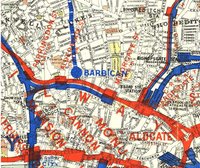
Late 19th- and early 20th-century urban rail transit maps that are held at the University of Chicago Library's Map Collection. The maps roughly illustrate the history of urban rail transit between the 1860s and the 1920s.
These years were the heyday of urban rail transit. Virtually every city in the Western world and in its colonial offshoots had street railroads during much or all of this period. Streetcars were drawn by horses in the early years. The invention of the grip cable in 1870s and of electric traction in the late 1880s greatly increased their speed and reliability. By the end of the 19th century, everyday urban life was completely dependent on this mode of transport.
A few cities, however, were so large and congested that street railroads were insufficient. Steam railroad lines served the suburbs but were unwelcome in the center of the city. London, the largest city in the Western world, acquired what is generally considered the first more or less modern subway system when, beginning in 1863, its Metropolitan steam railroad line was extended in shallow tunnels along the edges of the central city. (Frequent openings allowed some of the smoke to escape.) New York, whose population was growing even faster than London's, employed a different solution. Four steam-powered elevated railroads were built along most of the length of Manhattan. The first line opened in 1868. Although Istanbul acquired a short underground steam-powered funicular line (the "Tünel") in 1875 and Vienna opened a partly underground steam-powered rail line as late as 1898, the environmental drawbacks of steam power in the city discouraged other places from following suit.